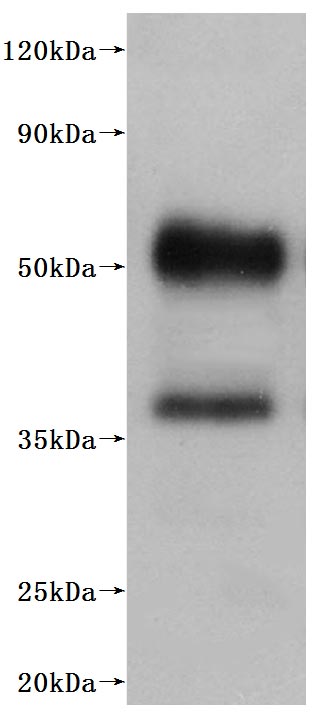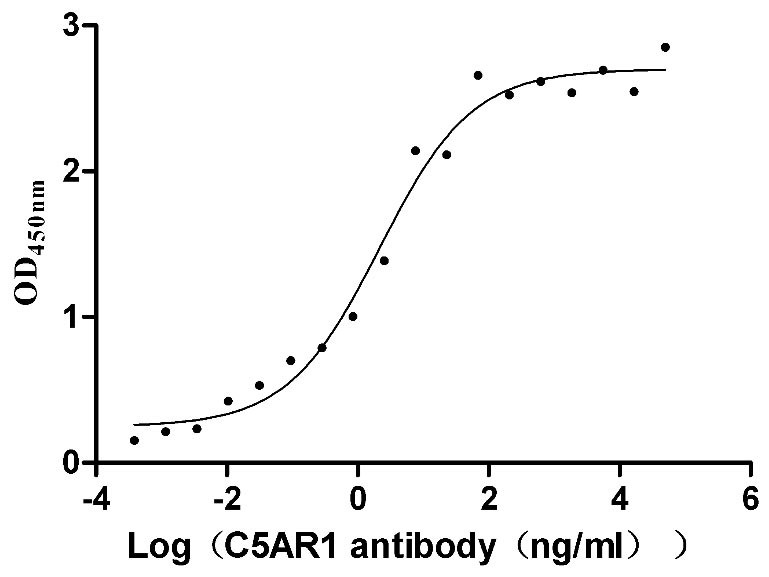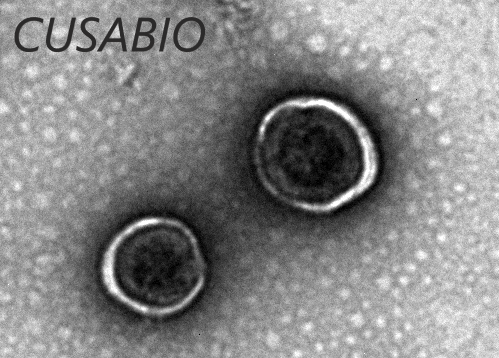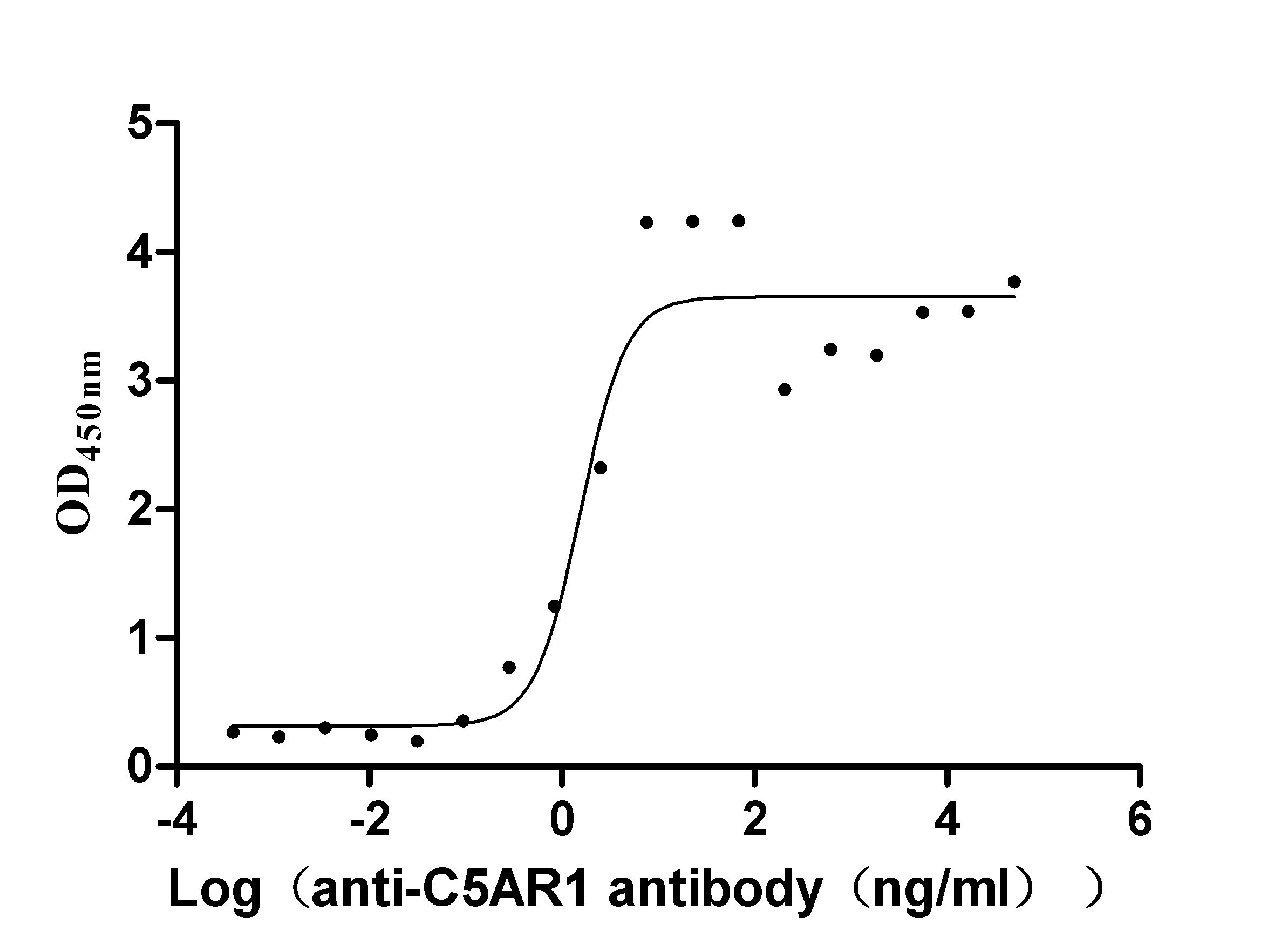Clone the gene encoding the human C5a anaphylatoxin chemotactic receptor 1 (C5AR1) protein (1-350aa) fused with the C-terminal 10xHis-tag gene into an expression vector along with the gene for VLP-forming viral capsid proteins. Introduce the recombinant expression vector into mammalian cells cultured under optimal conditions to induce protein expression to form VLPs containing the C5AR1 protein. Lyse the cells to release VLPs and then purify the VLPs through affinity chromatography. The presence of recombinant human C5AR1 VLPs has been confirmed by a transmission electron microscope (TEM). Their activity has been validated through a functional ELISA and their endotoxin content is less than 1.0 EU/ug.
C5aR1, also known as C5a receptor 1, is a protein that acts as a receiver for C5a, a molecule that triggers inflammation. Found in various immune cells, it's a key player in many body processes [1]. C5aR1 spurs conditions like cancer growth, kidney damage, and immune responses by rallying immune cells to the scene [2][3]. In colorectal cancer, it encourages cancer cells to change their behavior, contributing to tumor spread [1]. Interestingly, it seems to have different effects on different parts of the body - while it worsens kidney damage in high blood pressure, it protects the heart under certain conditions [2]. Additionally, C5aR1 seems to fuel processes like energy production in breast cancer and kidney infections caused by certain bacteria [4][5]. It's also involved in immune cell activity in muscle diseases like amyotrophic lateral sclerosis [6].
When C5a activates C5aR1, it sets off signals that attract immune cells and release inflammation-triggering molecules [3][8][9]. This receptor is also linked to how our body responds to inflammation and cancer, helping to create an environment that's not too inflammatory for tumors and allowing cancer cells to escape detection [10]. Moreover, it plays a part in allergic asthma and even influences how certain cells in our body turn into bone cells [11][12]. Despite being initially seen as just a decoy receptor, C5aR1 is now recognized as a crucial player in our health and how diseases progress [13][14].
References:
[1] D. Xu, M. Li, L. Ran, X. Li, X. Sun, & T. Yin, C5ar1 promotes the progression of colorectal cancer by emt and activating wnt/β-catenin pathway, Clinical & Translational Oncology, vol. 25, no. 2, p. 440-446, 2022. https://doi.org/10.1007/s12094-022-02956-y
[2] S. Weiß, A. Rosendahl, D. Czesla, C. Meyer-Schwesinger, R. Stahl, H. Ehmkeet al., The complement receptor c5ar1 contributes to renal damage but protects the heart in angiotensin ii-induced hypertension, Ajp Renal Physiology, vol. 310, no. 11, p. F1356-F1365, 2016. https://doi.org/10.1152/ajprenal.00040.2016
[3] K. Wu, N. Condon, T. Hill, R. Reid, D. Fairlie, & J. Lim, Ras-related protein rab5a regulates complement c5a receptor trafficking, chemotaxis, and chemokine secretion in human macrophages, Journal of Innate Immunity, vol. 15, no. 1, p. 468-484, 2023. https://doi.org/10.1159/000530012
[4] B. Ou, Y. Liu, X. Yang, X. Xu, Y. Yan, & J. Zhang, C5ar1-positive neutrophils promote breast cancer glycolysis through wtap-dependent m6a methylation of eno1, Cell Death and Disease, vol. 12, no. 8, 2021. https://doi.org/10.1038/s41419-021-04028-5
[5] K. Li, K. Wu, W. Wu, N. Wang, T. Zhang, N. Choudhryet al., C5ar1 promotes acute pyelonephritis induced by uropathogenic e. coli, Jci Insight, vol. 2, no. 24, 2017. https://doi.org/10.1172/jci.insight.97626
[6] H. Wang, J. Lee, K. Lee, T. Woodruff, & P. Noakes, Complement c5a-c5ar1 signalling drives skeletal muscle macrophage recruitment in the hsod1g93a mouse model of amyotrophic lateral sclerosis, Skeletal Muscle, vol. 7, no. 1, 2017. https://doi.org/10.1186/s13395-017-0128-8
[7] I. Llaudo, M. Fribourg, M. Medof, P. Conde, J. Ochando, & P. Heeger, C5ar1 regulates migration of suppressive myeloid cells required for costimulatory blockade-induced murine allograft survival, American Journal of Transplantation, vol. 19, no. 3, p. 633-645, 2019. https://doi.org/10.1111/ajt.15072
[8] S. Wisniewski, P. Dragan, A. Makal, & D. Latek, Helix 8 in chemotactic receptors of the complement system,, 2022. https://doi.org/10.1101/2022.03.07.483401
[9] F. Hubler, Discovery and characterization of a new class of c5ar1 antagonists showing in vivo activity, Journal of Medicinal Chemistry, vol. 67, no. 5, p. 4100-4119, 2024. https://doi.org/10.1021/acs.jmedchem.3c02375
[10] H. Shen, X. Gu, X. Li, X. Zheng, R. Zhang, S. Fanet al., C5ar1 shapes a non-inflammatory tumor microenvironment and mediates immune evasion in gastric cancer, Bosnian Journal of Basic Medical Sciences, 2022. https://doi.org/10.17305/bjbms.2022.8317
[11] A. Wiese, F. Ender, K. Quell, K. Antoniou, T. Vollbrandt, P. Königet al., The c5a/c5ar1 axis controls the development of experimental allergic asthma independent of lysm-expressing pulmonary immune cells, Plos One, vol. 12, no. 9, p. e0184956, 2017. https://doi.org/10.1371/journal.pone.0184956
[12] J. Cheng, X. Zhao, J. Liu, L. Cui, Y. Zhu, X. Yuanet al., Bioinformatic analysis of transcriptomic data reveals novel key genes regulating osteogenic differentiation of human adipose stem cells, Stem Cells International, vol. 2019, p. 1-10, 2019. https://doi.org/10.1155/2019/1705629
[13] P. Pundir, C. MacDonald, & M. Kulka, The novel receptor c5ar2 is required for c5a-mediated human mast cell adhesion, migration, and proinflammatory mediator production, The Journal of Immunology, vol. 195, no. 6, p. 2774-2787, 2015. https://doi.org/10.4049/jimmunol.1401348
[14] A. Thorenz, K. Derlin, C. Schröder, L. Dressler, V. Vijayan, P. Pradhanet al., Enhanced activation of interleukin-10, heme oxygenase-1, and akt in c5ar2-deficient mice is associated with protection from ischemia reperfusion injury–induced inflammation and fibrosis, Kidney International, vol. 94, no. 4, p. 741-755, 2018. https://doi.org/10.1016/j.kint.2018.04.005










